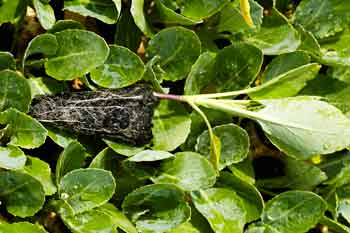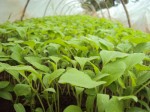Seedling growth medium – a commercial hydroponic perspective
Seedling growth medium fall into two categories.
- Those used for commercial seedling trays and
- mixtures used for propagating seedlings directly in the soil.
Commercial seedling growth medium mixtures are relatively expensive if small amounts of seedlings are to be produced. They are also most suited for seed trays. These mixtures are of the types A, B and C or combinations thereof. There are no fertilizers mixed into these growth mediums.
Growing seedlings in the soil needs an alternative approach. It would be too expensive to mix commercial seedling mixtures into the soil for seedling production. To grow seedlings directly in the soil one would have to prepare a seed bed. The most common way is to create a raised area of 1m x 2m (depending on the amount of seedlings required). One should never have a seedbed wider than 1m since it becomes too difficult to manage. The soil used for the raised area can be of Mixture D and E. The amount of fertilizer used should not be more than on 340ml for each 1m x 2m seed bed. Mixture combinations are as follows:
Various types of seedling mixtures that can be used in seedling trays and in soil for direct seeding| Mixture | Applicable to | Ingredients |
|---|---|---|
| A | Seedling trays | Vermiculite, fine bark and polystyrene |
| B | Seedling trays | Commercial seedling mixture |
| C | Seedling trays | Peat with vermiculite |
| D | Direct seeding in soil | Sieved sand, soil and compost with 2:3:2 (33) fertilizer. |
| E | Direct seeding in soil | Sterilized soil with 2:3:2 (33) fertilizer |
| Crop | Choice seedling mixture | Alternative mixture |
|---|---|---|
| Tomatoes | Mixture A, B | Mixture D, E |
| Peppers | Mixture A, B | Mixture D, E |
| Brinjals | Mixture A, B | Mixture D, E |
| Spinach | Mixture A, B, C | Mixture D, E |
| Cabbage | Mixture C, D | Mixture D, E |
| Celery | Mixture A, B | Mixture E |
| Marrows | Mixture A, B | Mixture D, E |
| Pumpkins | Mixture D | Mixture D, E |
| Lettuce | Mixture B | Mixture D |
Using only vermiculite as a seedling growth medium can cause the pH of the water to increase significantly to the point where it affects plant growth and yields. The growth medium should have the following characteristics in order to produce healthy seedlings:
Water holding capacity: The ability of the medium to hold water is extremely important. Most organic materials such as compost and peat have very good water holding capacities without causing water logged conditions. Sandy mediums (soils) tend to have very little water holding capacity and one has to irrigate frequently (up to 8 times a day). Soils or mediums that have a high clay content tend to become water logged quickly and need only to be irrigated one to three times a day.
Capacity to provide nutrients: The medium should have the capacity to hold and provide nutrients to the growing seedlings. Inert mediums such as vermiculite, peat, sand, rice husks contribute very little, if at all, to seedling nutrition. Thus the more one uses these materials the more one has to fertigate (add nutrients/fertilizers in the irrigation water). Mediums that are high in nutrients are compost, manure and soil.
Soil borne diseases: There are millions of fungi, viruses and bacteria in the soil and some of these are detrimental to seedlings. Most commercial seedling mixtures are sterilized. When using one’s own soil mixture, some type of sterilization should be applied in order not to lose all seedlings. The most effective method is some form of heat sterilization. Heat can be applied by either burning straw on top of the seed bed, by heating the soil in a drum with fire or by a method called Solarization. This is done by covering the seedbed with a transparent plastic sheet for three weeks. The heat of the sun increases the temperature of the soil, killing pathogenic micro-organisms (such as fungi, viruses and bacteria that are detrimental to plant growth), and weed seeds. It is important to irrigate the seedbed thoroughly after Solarization. Seedlings should be planted one day after the plastic has been removed from the soil. When selecting a medium ensure that the following has been done:
- All stones, rocks, rubbish such as glass, plastic, rotten material has been removed
- Ensure that the surrounding soil are not full of weeds and that the selected soil does not contain large amounts of seeds from weeds.
- Ensure that the site is relatively level (not with a steep gradient)
- Ensure that a watering point is close by
The size of a nursery will depend on the amount of seedlings that have to be raised. The table below provides a comparison of the relative size of the nursery should be using the two different sowing systems. It is evident that seedbeds need considerable more space than a nursery using seed trays.
The size of the nursery as determined by the number of seedlings that have to be grown en method used to plant the seedlings (seedbed or seed trays).| Number of seedlings | Size based on seedbeds | Size based on number of seed trays |
|---|---|---|
| 50 | 0.5m x 0.5m | 1m x 1m = 1 tray |
| 100 | 1m x 1m | 1m x 1m = 1 tray |
| 200 | 1m x 1m | 1m x 1m = 1 tray |
| 500 | 1m x 2.5m | 1m x 1m = 3 trays |
| 1000 | 1m x 4m | 1m x 1.5m = 5 trays |
| 1500 | 1m x 6m | 1m x 3m = 8 trays |
| 2000 | 1m x 8m | 1m x 3m = 10 trays |




